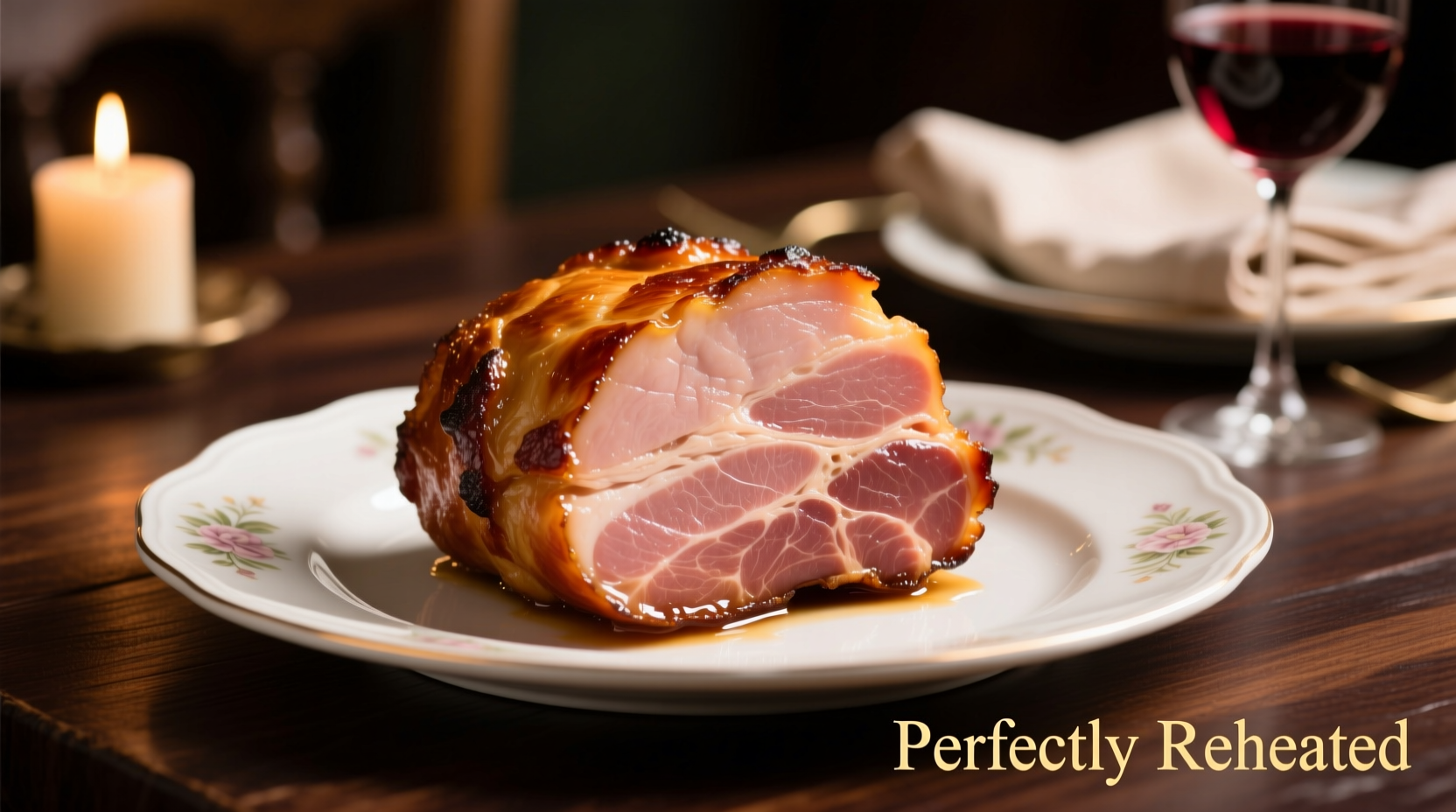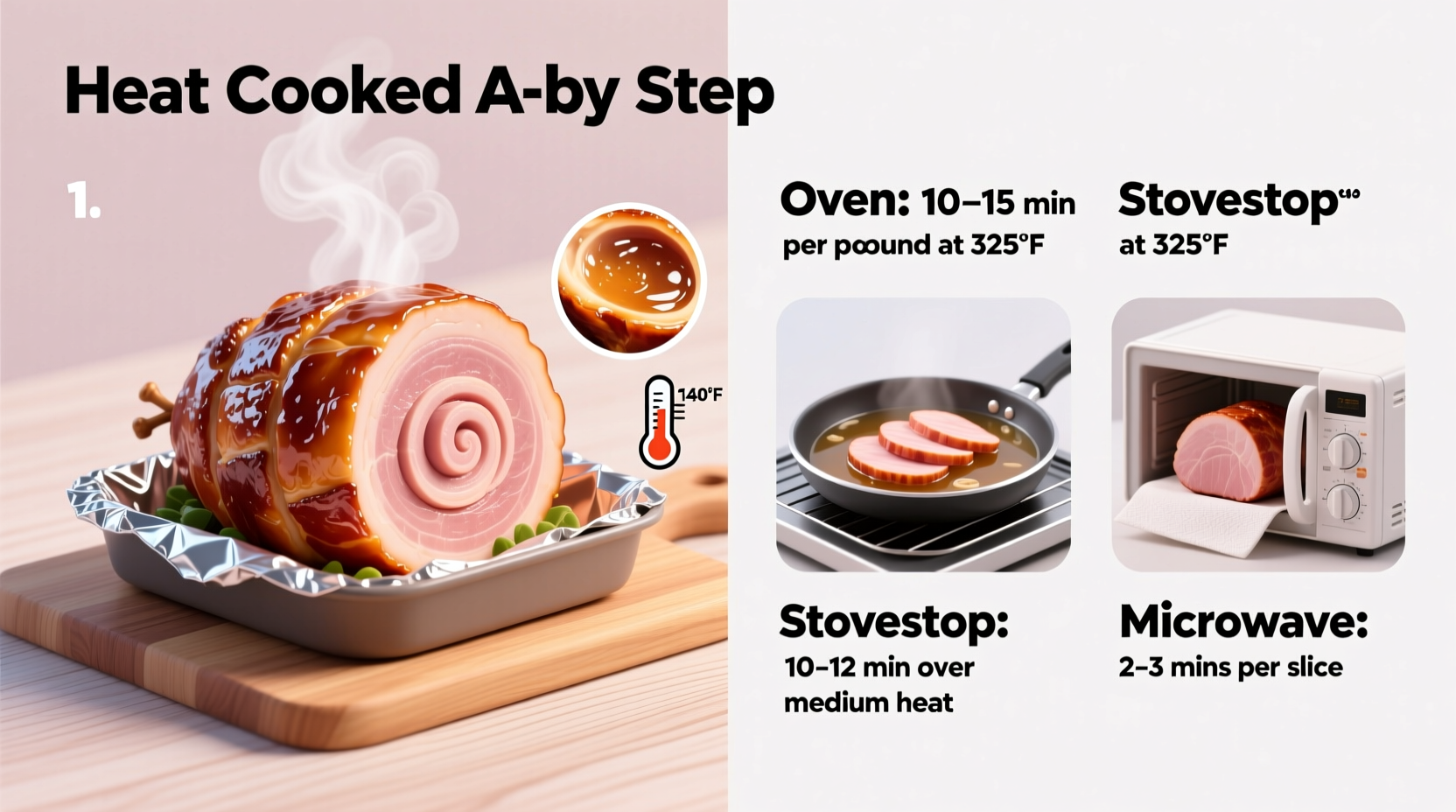Why Proper Ham Reheating Matters
Reheating cooked ham incorrectly leads to dry, tough meat that loses its delicate flavor. According to USDA Food Safety and Inspection Service guidelines, properly reheated ham maintains both safety and quality when handled correctly. Many home cooks make the critical mistake of using high heat or skipping moisture protection, which causes the precious juices to evaporate.
The Foolproof Oven Method (Best Results)
For optimal texture and flavor retention, follow these professional kitchen-tested steps:
- Preheat your oven to 325°F (163°C)—never higher, as excessive heat dries ham rapidly
- Place ham cut-side down in a roasting pan with shallow sides
- Add 1/4 cup liquid (water, broth, or apple juice) to the pan bottom
- Tightly wrap entire ham in heavy-duty aluminum foil
- Insert meat thermometer through foil into thickest part
- Heat 10-15 minutes per pound until internal temperature reaches 140°F
- Rest 10 minutes before slicing to redistribute juices
This technique creates a steam environment that prevents moisture loss while ensuring even heating. Professional chefs at the Culinary Institute of America recommend this approach for holiday leftovers because it maintains the ham's delicate texture.

Alternative Reheating Methods Compared
When oven space is limited or you need faster results, these alternatives work with proper adjustments:
| Method | Best For | Time Required | Moisture Retention | Food Safety Tip |
|---|---|---|---|---|
| Oven (foil-wrapped) | Whole hams, holiday leftovers | 10-15 min/lb | Excellent | Use thermometer to verify 140°F internal temp |
| Slow Cooker | Sliced ham portions | 2-3 hours on LOW | Very Good | Add 1/2 cup liquid; check temp after 2 hours |
| Stovetop (saucepan) | Thin slices, quick meals | 5-8 minutes | Good | Cover with lid; use low heat with broth |
| Microwave | Emergency reheating | 2-4 minutes | Fair | Cover with damp paper towel; heat in 30-sec intervals |
Food Safety Temperature Timeline
Understanding the critical temperature zones prevents both foodborne illness and quality loss. The USDA Food Safety and Inspection Service specifies these key temperature points:
- 40°F-140°F: Danger Zone – Bacteria multiply rapidly; ham shouldn't remain in this range more than 2 hours
- 140°F: Safe Minimum – Proper reheating temperature for cooked ham (per USDA guidelines)
- 165°F: Critical Threshold – Temperature where ham begins significant moisture loss
When reheating, move ham quickly through the danger zone by starting with properly refrigerated leftovers (below 40°F) and heating directly to 140°F. Never partially reheat then refrigerate again—this doubles your risk exposure in the danger zone.
Scenario-Specific Reheating Tips
Different situations require tailored approaches:
- Spiral-cut hams: Place cut-side down, cover entire ham with foil, add extra liquid (1/2 cup) as cuts expose more surface area
- Glazed hams: Reheat without glaze, then apply fresh glaze during last 15 minutes for perfect caramelization
- Leftover slices: Stack between damp parchment paper in microwave-safe dish for even heating
- Pre-sliced deli ham: Use stovetop method with broth to prevent curling and drying
Common Reheating Mistakes to Avoid
Even experienced cooks make these critical errors:
- Skipping the thermometer: Guessing doneness leads to underheated (unsafe) or overcooked (dry) ham
- Using high oven temperatures: 350°F+ causes rapid moisture loss despite foil wrapping
- Reheating uncovered: Essential moisture escapes, especially problematic for spiral-cut varieties
- Ignoring resting time: Cutting immediately releases precious juices onto the cutting board
Proper Leftover Storage for Future Reheating
How you store leftovers determines reheating success. Follow these steps:
- Cool ham within 2 hours of cooking (USDA food safety requirement)
- Slice or portion before storing for faster, more even reheating later
- Place in airtight container with 2-3 tablespoons of cooking liquid
- Refrigerate up to 3-4 days or freeze up to 2 months
- Thaw frozen ham in refrigerator 24-48 hours before reheating
When stored properly, reheated ham maintains 90% of its original quality. The National Pork Board's research shows that vacuum-sealed storage with liquid preserves moisture significantly better than standard containers.











 浙公网安备
33010002000092号
浙公网安备
33010002000092号 浙B2-20120091-4
浙B2-20120091-4